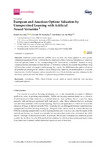European and American Options Valuation by Unsupervised Learning with Artificial Neural Networks

Use this link to cite
http://hdl.handle.net/2183/26632Collections
- Investigación (FIC) [1681]
Metadata
Show full item recordTitle
European and American Options Valuation by Unsupervised Learning with Artificial Neural NetworksDate
2020-08-19Citation
Salvador, B.; Oosterlee, C.W.; Meer, R. European and American Options Valuation by Unsupervised Learning with Artificial Neural Networks. Proceedings 2020, 54, 14.
Abstract
[Abstract]
Artificial neural networks (ANNs) have recently also been applied to solve partial differential equations (PDEs). In this work, the classical problem of pricing European and American financial options, based on the corresponding PDE formulations, is studied. Instead of using numerical techniques based on finite element or difference methods, we address the problem using ANNs in the context of unsupervised learning. As a result, the ANN learns the option values for all possible underlying stock values at future time points, based on the minimization of a suitable loss function. For the European option, we solve the linear Black–Scholes equation, whereas for the American option, we solve the linear complementarity problem formulation.
Keywords
(Non)linear PDEs
Black–Scholes model
Artificial neural network
Loss function
Multi-asset options
Black–Scholes model
Artificial neural network
Loss function
Multi-asset options
Editor version
Rights
Atribución 4.0 España
ISSN
2504-3900






